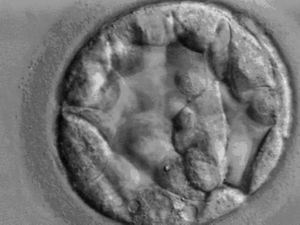Blastocyst Embryonic Development - Anatomy & Physiology
Pre-Implantation Development
- The sperm enters the the oocyte forming the ootid.
- In the ootid, male and female pronuclei along with the first and second polar bodies are present.
- Fusion of the male and female pronuclei results in a single diploid nucleus (syngamy)
- The zona pellucida then becomes an imprenetrable layer that prevents polyspermy and so polyploidy.
- Zygote (diploid) undergoes mitotic divisions (cleavage).
- Cleavage gives rise to daughter cells called blastomeres.
- Cleavage divisions continue and the 4-celled embryo gives rise to an 8-celled embryo.
- These cells are totipotent and divide asynchronously.
- After the 8-celled stage, a ball of cells is formed. This stage is referred to as a morula.
- Tight junctions form between outer cells of the morula.
- Gap junctions form between inner cells of the morula.
- Thus, two groups of cells are created within the morula.
- Outer cells pump sodium into the intracellular spaces and water follows osmotically.
- Fluid begins to accumulate within the morula.
- Cells of the morula continue to divide and a blastocyst develops, consisting of:
- Inner cell mass (ICM)
- Blastocoele cavity
- Single layer of trophoblast cells
- As fluid accumulates, the outer cells become flattened and a cavity known as the blastocoele is formed.
- Gap junctions connecting the inner cells of the morula enable them to polarise as a group.
- As a result, two separate cellular components emerge - the inner cell mass and the trophoblasts.
- Blastocyst continues mitosis.
- Fluid accumulates to fill the blastocoele and pressure within the embryo increases.
- Concurrent with growth and fluid accumulation is the production of proteolytic enzymes by trophoblastic cells.
- Enzymes weaken the zona pellucida.
- Blastocyst begins to contract and relax causing intermittent pressure pulses on the zona pellucida.
- Zona pellucida ruptures with the development of a small fissure just large enough for the blastocyst to squeeze out.
- Blastocyst 'hatches' from the zona pellucida.
- Rodent, Dog, Cat, Primate: 8 days after fertilization
- Ungulates: 12 days after fertilization.
- Blastocyst free-floating within the uterus, totally dependent on the uterine environment for survival.
